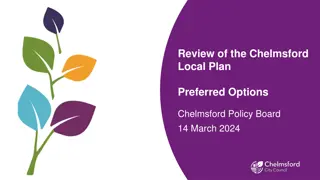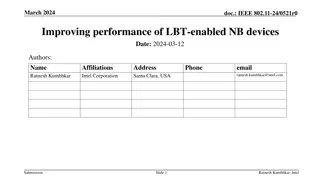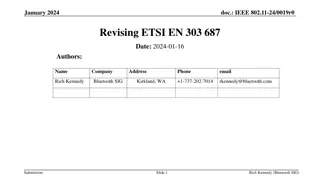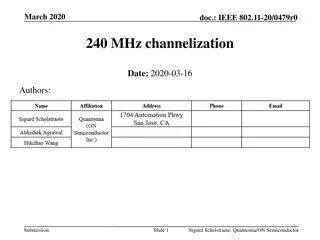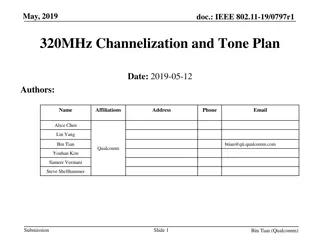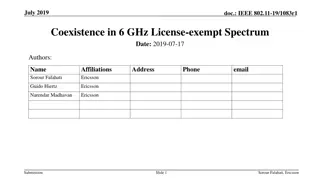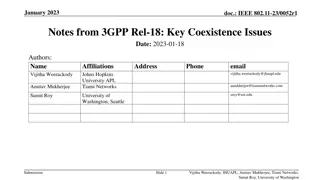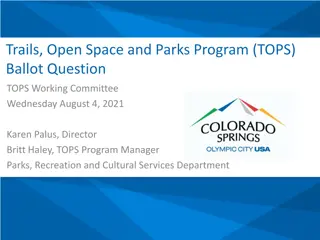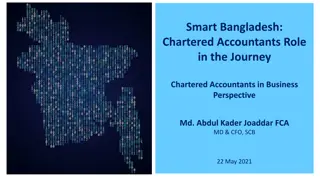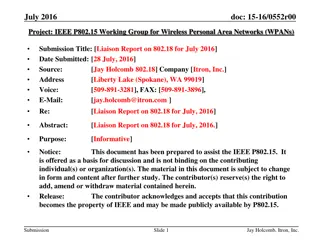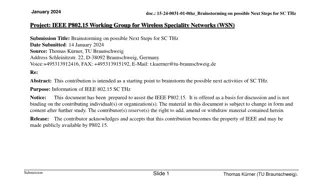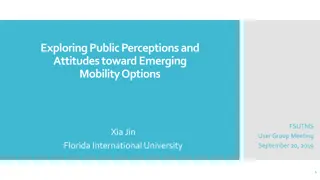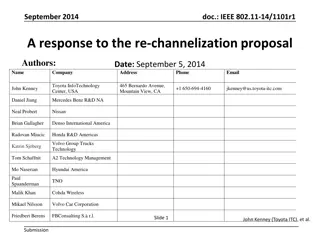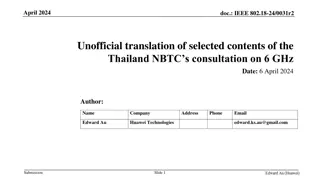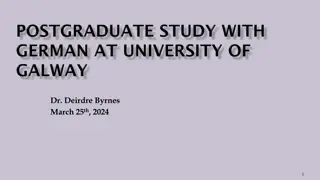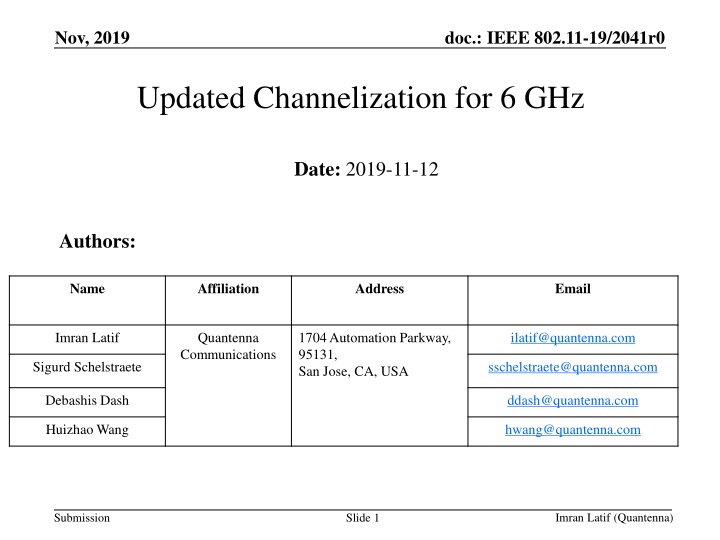
Proposal for Enhanced Channelization in the 6 GHz Band
Explore the proposed channelization updates for the 6 GHz band in IEEE 802.11-19/2041r0 to address inefficiencies and uncertainties, ensuring timely implementation without dependence on final regulatory rules. Imran Latif from Quantenna Communications presents a solution agnostic to regulatory constraints, offering insights into FCC proposals and rule-making processes in Europe related to 6 GHz operations.
Download Presentation

Please find below an Image/Link to download the presentation.
The content on the website is provided AS IS for your information and personal use only. It may not be sold, licensed, or shared on other websites without obtaining consent from the author. If you encounter any issues during the download, it is possible that the publisher has removed the file from their server.
You are allowed to download the files provided on this website for personal or commercial use, subject to the condition that they are used lawfully. All files are the property of their respective owners.
The content on the website is provided AS IS for your information and personal use only. It may not be sold, licensed, or shared on other websites without obtaining consent from the author.
E N D
Presentation Transcript
Nov, 2019 doc.: IEEE 802.11-19/2041r0 Updated Channelization for 6 GHz Date: 2019-11-12 Authors: Name Affiliation Address Email Imran Latif Quantenna Communications 1704 Automation Parkway, 95131, San Jose, CA, USA ilatif@quantenna.com Sigurd Schelstraete sschelstraete@quantenna.com Debashis Dash ddash@quantenna.com Huizhao Wang hwang@quantenna.com Imran Latif (Quantenna) Submission Slide 1
Nov, 2019 doc.: IEEE 802.11-19/2041r0 Background 11ax supports operation in the 6 GHz band so channelization definition for 6 GHz is important In 11-19/876 and 11-19/1199r1 it was shown that current 6 GHz channelization (draft 5.0) is not efficient in terms of useful channels Main issue arrives from the uncertainties from the regulatory bodies If we keep on waiting for final rules from regulatory bodies, it would be too late for 11ax In this presentation we propose a way forward which is agnostic to the regulations imposed by regulatory authorities Comment # 22048 Slide 2 Imran Latif (Quantenna) Submission
Nov, 2019 doc.: IEEE 802.11-19/2041r0 FCC Proposal so far Proposed band [MHz] Total Available Bandwidth [MHz] Transmission Rules Access Mechanism Power Requirements Standard-Power AP AFC Required 1 watt , max PSD 17 dBm/Mhz U-NII-5 5925-6425 500 Similar to UNI-1, 3 250 mwatts , max PSD 11 dBm/Mhz U-NII-6 6425-6525 100 Similar to UNI-2 Low Power AP No AFC required Standard-Power AP AFC Required 1 watt , max PSD 17 dBm/Mhz U-NII-7 6525-6875 350 Similar to UNI-1, 3 250 mwatts , max PSD 11 dBm/Mhz U-NII-8 6875-7125 250 Similar to UNI-2 Low Power AP No AFC required Imran Latif (Quantenna) Submission Slide 3
Nov, 2019 doc.: IEEE 802.11-19/2041r0 FCC rule making 1. Administrative Procedure Act (APA) 1. Informal rule making NPRM NPRM publication (December - 2018) 1. In federal register Public comment period 1. 30 days Reply Comments 1. 30-45 days Ex-parte presentations and comments (No period defined) 1. Continues until start of Sunshine Period, which begins with the issuance of a public notice one week before the public meeting at which the Commission will consider an NPRM or final rule. Public docket 1. The public dockets for the FCC are maintained on the Electronic Comment Filing System (ECFS), which is accessible on the Internet athttp://apps.fcc.gov/ecfs/. Peer review Logical outgrowth test 1. Could potentially start new public comments 10. Final rule publication (R&O) 2. 3. 4. 5. 6. 7. 8. 9. Imran Latif (Quantenna) Submission Slide 4
Nov, 2019 doc.: IEEE 802.11-19/2041r0 6 GHz rulemaking in Europe Imran Latif (Quantenna) Submission Slide 5
Nov, 2019 doc.: IEEE 802.11-19/2041r0 11ax Timeline Milestone Expected Date SA Ballot Pool formation Done (Sep 2019) MDR Done Done (Sep 2019) Initial SA Ballot Mar 2020 Final SA Ballot Jul 2020 802.11 WG Approval Sep 2020 802 EC Approval Nov 2020 Revcom and SB approval Nov 2020 Working group Ballot is on-going (LB244) Next step is SA Ballot scheduled March 2020 Before completion of SA Ballot, we need to resolve all the comments and add support for all supported features of 11ax. (preferably earlier) Imran Latif (Quantenna) Submission Slide 6
Nov, 2019 doc.: IEEE 802.11-19/2041r0 Current Channel Allocation AFC No AFC AFC No AFC Starting frequency of 5940 MHz Only 10 MHz of Guard band for U-NII-5 Challenging filter design Channels can cross U-NII boundaries In case U-NII-5 and 6 work under different regulatory rules No 80 MHz channel in U-NII-6 Only one 40 MHz channel in U-NII-6 Center Frequency [MHz] 20 MHz Channels 40 MHz Channels 80 MHz Channels 160 MHz Channels to AFC or not AFC? Imran Latif (Quantenna) Submission Slide 7
Nov, 2019 doc.: IEEE 802.11-19/2041r0 Proposed Channel Allocation No AFC AFC AFC No AFC Starting frequency of 5950 MHz 20 MHz of guard band Channelization is proposed to be per U-NII band basis Narrow-band filter design Vs. Wide-band filter design This addresses the issue of having three 160 MHz channels in U-NII 5 This addresses the issue of getting two 40 MHz and one 80 MHz channel This addresses the problem of having different regulations for different U-NII bands (AFC agnostic) **we get two 320 MHz channels, one in U-NII-5 and another in U-NII-7 (both are under AFC in current NPRM) 20 MHz 40 MHz 80 MHz 160 MHz 320 MHz ** more valid for 11be Imran Latif (Quantenna) Submission Slide 8
Nov, 2019 doc.: IEEE 802.11-19/2041r0 6 GHz in Europe 6 GHz unlicensed band in Europe is essentially what FCC is referring as U- NII-5, i.e., from 5925 to 6425 MHz Currently nothing like AFC in USA is proposed for 6 GHz access in the EU We are aware and well-concerned that providing a 20 MHz of shift above 5925MHz can make the filter design for the higher end of the band very challenging for EU To cope with it we need to have relaxed OOBE limits towards 6425 MHz Also some countries in EU are inclined to have this 20 MHz shift due to protection of bands below 5925 MHz. Slide 9 Imran Latif (Quantenna) Submission
Nov, 2019 doc.: IEEE 802.11-19/2041r0 Comparison of number of channels Current Channel BW/ U-NII Band 20 MHz 40 MHz 80 MHz 160 MHz U-NII-5 U-NII-6 U-NII-7 U-NII-8 24 12 6 3 4 1 0 0 17 8 3 1 12 5 2 1 Proposed channel allocation Channel BW/ U-NII Band 20 MHz 40 MHz 80 MHz 160 MHz U-NII-5 U-NII-6 U-NII-7 U-NII-8 24 12 6 3 5 2 1 0 17 8 4 2 12 6 3 1 Imran Latif (Quantenna) Submission Slide 10
Nov, 2019 doc.: IEEE 802.11-19/2041r0 Summary and Discussion We raise an important point about channelization in the 6 GHz band Current channelization is in-efficient and is not fit for the future changes for the 6 GHz band We presented a proposal with two parts Part 1 - We propose to increase the guard-band on lower U-NII-5 from 10 to 20 MHz, shifting starting frequency from 5940 to 5950 MHz Part 2 We propose to perform channelization for each U-NII-band separately thus making it regulations agnostic (AFC, no AFC etc.) Proposal to have separate channelization for each U-NII band introduces huge flexibility in filter design and addresses the uncertainties which are associated with Regulation of 6 GHz band worldwide. Furthermore, we presented how two 320 MHz channels can be obtained from this proposed channelization. Imran Latif (Quantenna) Submission Slide 11
Nov, 2019 doc.: IEEE 802.11-19/2041r0 Strawpoll - 1 Do you agree that channelization should be performed for each U-NII band separately? (making it agnostic to regulations) Y N A Imran Latif (Quantenna) Submission Slide 12
Nov, 2019 doc.: IEEE 802.11-19/2041r0 Strawpoll - 2 Do you support proposal with 20 MHz start guard band in U-NII-5 ? Y N A Imran Latif (Quantenna) Submission Slide 13


